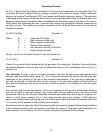28
TROUBLESHOOTING
Display does not come on or is weak.
Check power and ground connections.
Flow reading is approximately xed either near zero or near full scale regardless of actual line
ow.
Differential pressure sensor may be damaged. Avoid installations that can subject sensor to pressure
drops in excess of 10 PSID. A common cause of this problem is instantaneous application of high-
pressure gas as from a snap acting solenoid valve upstream of the meter. Damage due to excessive
pressure differential is not covered by warranty.
Displayed mass ow, volumetric ow, pressure or temperature is ashing and message MOV,
VOV, POV or TOV is displayed:
Our ow meters and controllers display an error message (MOV = mass overrange, VOV = volumetric
overrange, POV = pressure overrange, TOV = temperature overrange) when a measured parameter
exceeds the range of the sensors in the device. When any item ashes on the display, neither the
ashing parameter nor the mass ow measurement is accurate. Reducing the value of the ashing
parameter to within specied limits will return the unit to normal operation and accuracy.
Meter reads negative ow when there is a conrmed no ow condition.
This is an indication of an improper tare. If the meter is tared while there is ow, that ow is accepted as
zero ow. When an actual zero ow condition exists, the meter will read a negative ow. Simply re-tare
at the conrmed zero ow condition. Also note that while the meter is intended for positive ow, it will
read negative ow with reasonable accuracy (it is not calibrated for bi-directional ow) and no damage
will result.
Meter does not agree with another meter I have in line.
Volumetric meters will often not agree with one another when put in series because they are affected
by pressure drops. Volumetric ow meters should not be compared to mass ow meters. Mass ow
meters can be compared against one another provided there are no leaks between the two meters and
they are set to the same standard temperature and pressure. Both meters must also be calibrated (or
set) for the gas being measured. M Series mass ow meters are normally set to Standard Temperature
and Pressure conditions of 25° C and 14.696 PSIA. Note: it is possible to special order meters with a
customer specied set of standard conditions. The calibration sheet provided with each meter lists its
standard conditions.
Flow utters or is jumpy.
The meters are very fast and will pick up any actual ow uctuations such as from a diaphragm pump,
etc. Also, inspect the inside of the upstream connection for debris such a Teon tape shreds. Note: M
& V Series meters feature a programmable geometric running average (GRA) that can aid in allowing
a rapidly uctuating ow to be read.
The output signal is lower than the reading at the display.
This can occur if the output signal is measured some distance from the meter as voltage drops in the
wires increase with distance. Using heavier gauge wires, especially in the ground wire, can reduce this
effect.
My volumetric meter reading is strange, inconsistent, or incorrect.
Make sure you use a volumetric ow meter only under low pressure (close to atmospheric) and with
little to no back pressure for accurate readings. Mass meters should be used for higher pressure
applications. See page 26.
RS-232 Serial Communications is not responding.
Check that your meter is powered and connected properly. Be sure that the port on the computer to which
the meter is connected is active. Conrm that the port settings are correct per the RS-232 instructions
in this manual (Check the RS-232 communications select screen for current meter readings). Close
HyperTerminal® and reopen it. Reboot your PC.


















